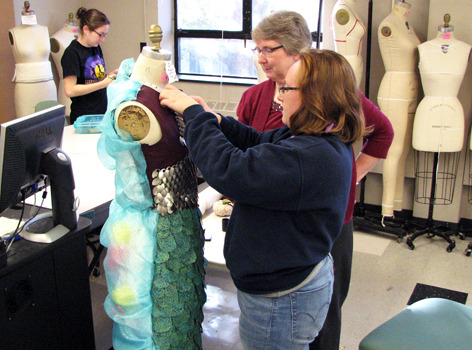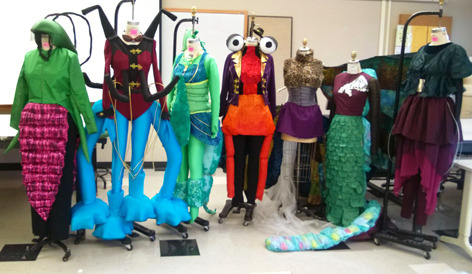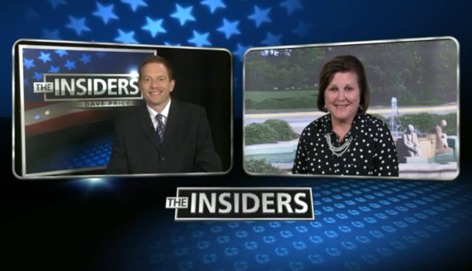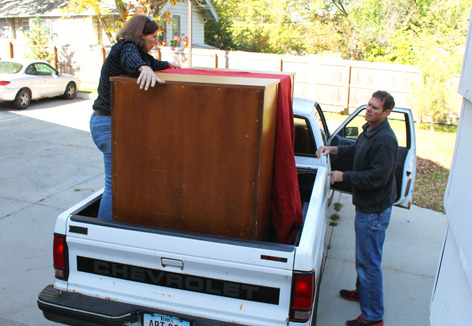Students create alien costumes for gardens event

Junior Jorden Charron attaches the last of about 300 metal scales to her Scaley Invasion costume earlier this week as instructor Sharon Wirth looks on. Photo by Anne Krapfl.
Seven apparel design students this fall faced a real-world challenge: Meet the deadline, stay on budget and keep the client happy. (And don't slack on your other classes.) Meeting nine hours a week for the first eight weeks of the semester – and putting in loads of hours at home -- the seven students each designed and produced a "nature-inspired" alien costume for Reiman Gardens. Collectively they feature leaves, wings, scales, blossoms, tails, antennae and leg sets exceeding two.
Guests at this weekend's Spirits in the Gardens will be treated to the fruits of that labor when models don the costumes to interact with children at the ninth annual pre-Halloween event. The costumes complement the gardens' 2014 space/science fiction theme, but needed to adhere to "alien" guidelines set by gardens staff that included:
- Colorful
- Inspired by real plants or animals
- Friendly, not scary
- Face and hands remain exposed (lest young children forget it's a costumed human)
The seven seamstresses also were tasked early on with recruiting a model for their costumes, individuals with both flexible schedules – to attend lots of fittings – and engaging personalities for Spirits in the Gardens.
The students and their costumes
Julie Anderson, senior, Jaded Layla
Jorden Charron, junior, Scaley Invasion
Hayley Hays, senior, Royal Damsel
Kerry Maas, junior, Flower From Far Out
Sarah Martin, junior, Icarina Exotica
Mackenzie Thacker, senior, Queen Beetle
Haley Wandro, junior, Alien Insect
Class project
As in 2011, the apparel, merchandising and design program's 300-level design seminar this fall was tailored to Reiman Gardens' request for theme-based costumes. Sharon Wirth, who co-teaches the seminar and runs the program's teaching laboratory, called it a "wonderful collaboration."
"This experience forces our students to fit their creativity within the parameters of a client's needs, to work with a real-world budget and to get the project done in eight weeks," Wirth said. "It's a big challenge for them, but Reiman Gardens is wonderful to work with."
While many of the projects narrowly exceeded the $200 budget, students said honoring the client's costume guidelines proved most challenging.
"Designing for kids required a new way of thinking," said senior Julie Anderson. "In the beginning, I had some really awesome ideas, but they would have been way too scary."
Her colleague, junior Haley Wandro, concurred.
"I'm more technical than creative, so the curveball for me was having to keep the face uncovered," Wandro said. Eventually, she settled on blue face paint and hair spray with her costume.
Showtime
Spirits in the Gardens will be held Saturday and Sunday, Oct. 25-26 (4-7 p.m.). Guests of all ages are encouraged to come in costume (but it isn't required). Activities include:
- Trick-or-treating
- Hawk and owl demonstration by students from the College of Veterinary Medicine's Wildlife Care Clinic
- Storytelling with Jerri Heid, youth services manager at the Ames Public Library
- Mask-making craft
- Outdoor games such as bean bag toss and pumpkin broomball
- Meet the garden aliens and the students who created them
Spirits in the Gardens is free for all youth under age 18; adults and seniors pay regular garden admission ($8 and $7, respectively). Garden admission is free for members and Iowa State students with valid ID card.

The seven nature-inspired alien costumes created by members of the apparel, merchandising and design program's fall design seminar. Photo by Sharon Wirth.
Live, from Iowa State

WHO-TV's Dave Price interviews politics expert Dianne Bystrom.
Iowa State's new live broadcast studio got its first road test last week when Dianne Bystrom, director of the Carrie Chapman Catt Center for Women in Politics, sat in front of the Fountain of the Four seasons backdrop in the Communications Building and answered questions posed by a newscaster in Des Moines.
The interviewer, WHO-TV's Dave Price, was only 40 miles down the road. But the new technology employed in the studio just as easily could have streamed Bystrom halfway around the world.
A small appliance in the studio provides a live, high-quality video connection from Iowa State to a large global network -- LTN Smart Global. Video originating from Iowa State can be transmitted to other LTN appliances and to non-LTN networks and teleport centers throughout the world.
"The Internet-based technology is more reliable than satellites, with virtually no transmission delay and at a tiny fraction of satellite costs," said ISU news service director Annette Hacker. "LTN also connects to all the major TV news networks. That translates into more opportunities for Iowa State faculty to share their expertise and research nationally."
Aging equipment prompts tech search
A live shot from campus became something of a long shot in 2012, due to aging satellite technology and the end of an agreement with WOI-TV to provide technical services to the university.
"There wasn't an obvious solution to replacing satellite technology, which is both expensive and on the wane," Hacker said. "We used Skype to some extent, but networks run hot and cold as to whether they'll accept it."
A CNN producer who'd worked with news service pointed Hacker to a couple of CNN engineers, who, in turn, suggested the LTN technology. It was a good tip. Several universities already using the technology reported positive results.
Once the technology question was settled, university relations secured space -- 1028 Communications Building -- and remodeled it to accommodate a fully equipped, digital broadcast studio, green room and small conference room.
"We are extremely grateful to senior vice president Warren Madden for his support and assistance in making this happen," Hacker said. "The new studio is a convenient, effective way to move university knowledge and know-how far beyond our campus."
Reuse, recycle

Volunteers Dave and Diane Faris, Des Moines, load several ISU dressers destined for families in a St. Anthony's School outreach program. Submitted photo.
About 45 dressers from Friley Hall, at the end of their normal use cycle but deemed not salable by ISU Surplus, were donated to nonprofit groups across central Iowa earlier this month.
The residence department, which repurposes items every year from its inventory, alerted ISU director of sustainability Merry Rankin, who contacted the Iowa DNR's waste exchange program. IWE's Shelly Codner put out the word with numerous nonprofit offices in the mid-section of the state. With the assistance of Two Men and a Truck, student workers and local volunteers, the dressers were loaded and delivered to four nonprofit service groups: St. Joseph Emergency Family Shelter and St. Anthony’s School Spanish immersion program in Des Moines; and the Bridge of Hope and La Luz Hispana ministries in Hampton.
History prof says storytelling is key to engaging students
Lectures. The mere mention of the word evokes images of blank stares and absent-minded doodling. But associate professor of history John Monroe has a remedy that will corral students' attention during lectures. He shared his ideas during an Oct. 22 award-winning faculty series presentation (yes, it was a lecture) called "Maximizing Student Attention: Low-tech Effectiveness in Large Lecture Formats." The series is organized by the Center for Excellence in Learning and Teaching.
Why lectures stand the test of time
Monroe said he believes lectures evolved through the centuries because of one common thread: Students are listening to an instructor at the same time they are writing notes. He went on to say that lectures are effective supplements to reading.
"What a student gets in the text portion of the class is raw information, the basic stuff of knowledge; what the lecture provides is a model for thinking through that raw information, analyzing it, making sense of it, and generally using it as the basis for independent, intellectual inquiry," Monroe said.
Tell a story
As a new professor about a decade ago, Monroe was faced with teaching roughly 400 Iowa State students 500 years worth of European social, political, economic and cultural events in a western civilization class. At first, Monroe said he was a bit intimidated. But then he remembered some of the most memorable lectures his former professors gave and realized they shared a key trait -- storytelling.
Monroe contends the best lectures have a narrative structure with a defined beginning, middle and end. Here are his tips for constructing a lecture in this way:
- Narratives don't have to be about individual people, or even people at all. They need an identifiable "protagonist" and a coherent movement from beginning to middle to end.
- Before preparing individual lectures, devise a narrative arc for your entire course. What is the climax, the most important lecture of the entire term? Determine that, and then build to it. (It works best if the climax is two-thirds or three-quarters of the way into the term.)
- Give each lecture its own story (beginning, middle and end) while remaining aware of its place in the course's overall narrative arc.
- When delivering your lectures, give clear statements that indicate where you will go and where you've been. In narratives about ideas, processes and things, this signposting is even more important.
Distractions are OK
Monroe said that listening and taking notes during lectures is demanding for students.
"To maintain student focus overall, it's important to create moments when that focus doesn't need to be so intense," he said.
He advises faculty members to intersperse colorful bits of information with important key points, which gives students a chance to relax their attention. Following are Monroe's tips for keeping students' attention:
- Let students relax their concentration occasionally.
- Experiment with "controlled tangents" -- moments when you stray from the text to add an interesting side note or bit of color.
- Make PowerPoint presentations more about images than text, and keep the text component to a minimum. This will encourage students to take notes while still giving them cues about the subject when their attention strays.
- Instead of a detailed PowerPoint printout, create a broader outline sheet with some points left intentionally mysterious to encourage students to clarify by taking notes.
- If you can, give students a feeling of emotional connection. This is the theatrical element of lecturing. Generally, it involves introducing a personal touch. The basic way to do this is to figure out a way to discuss the day's subject in a manner you find interesting. It could be the topic you choose or it might involve humor, research stories or anecdotes from daily life. The nature of this element should vary with the instructor's personality. In all cases, the goal is to convey a sense of authentic enthusiasm for the subject.
